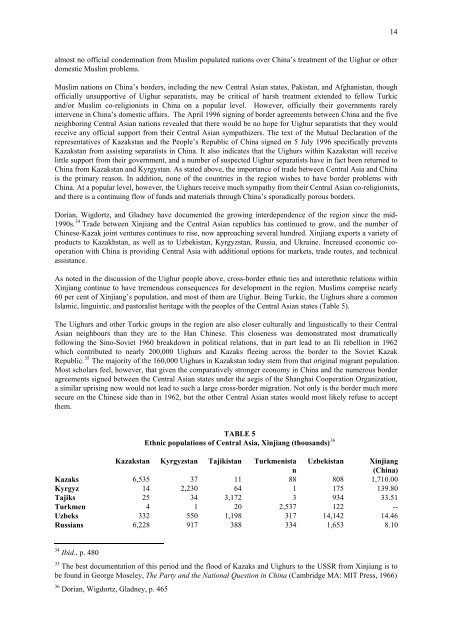Dru C. Gladney, Ph.D. - House Foreign Affairs Committee Democrats
Dru C. Gladney, Ph.D. - House Foreign Affairs Committee Democrats
Dru C. Gladney, Ph.D. - House Foreign Affairs Committee Democrats
You also want an ePaper? Increase the reach of your titles
YUMPU automatically turns print PDFs into web optimized ePapers that Google loves.
14<br />
almost no official condemnation from Muslim populated nations over China’s treatment of the Uighur or other<br />
domestic Muslim problems.<br />
Muslim nations on China’s borders, including the new Central Asian states, Pakistan, and Afghanistan, though<br />
officially unsupportive of Uighur separatists, may be critical of harsh treatment extended to fellow Turkic<br />
and/or Muslim co-religionists in China on a popular level. However, officially their governments rarely<br />
intervene in China’s domestic affairs. The April 1996 signing of border agreements between China and the five<br />
neighboring Central Asian nations revealed that there would be no hope for Uighur separatists that they would<br />
receive any official support from their Central Asian sympathizers. The text of the Mutual Declaration of the<br />
representatives of Kazakstan and the People’s Republic of China signed on 5 July 1996 specifically prevents<br />
Kazakstan from assisting separatists in China. It also indicates that the Uighurs within Kazakstan will receive<br />
little support from their government, and a number of suspected Uighur separatists have in fact been returned to<br />
China from Kazakstan and Kyrgystan. As stated above, the importance of trade between Central Asia and China<br />
is the primary reason. In addition, none of the countries in the region wishes to have border problems with<br />
China. At a popular level, however, the Uighurs receive much sympathy from their Central Asian co-religionists,<br />
and there is a continuing flow of funds and materials through China’s sporadically porous borders.<br />
Dorian, Wigdortz, and <strong>Gladney</strong> have documented the growing interdependence of the region since the mid-<br />
1990s. 34 Trade between Xinjiang and the Central Asian republics has continued to grow, and the number of<br />
Chinese-Kazak joint ventures continues to rise, now approaching several hundred. Xinjiang exports a variety of<br />
products to Kazakhstan, as well as to Uzbekistan, Kyrgyzstan, Russia, and Ukraine. Increased economic cooperation<br />
with China is providing Central Asia with additional options for markets, trade routes, and technical<br />
assistance.<br />
As noted in the discussion of the Uighur people above, cross-border ethnic ties and interethnic relations within<br />
Xinjiang continue to have tremendous consequences for development in the region. Muslims comprise nearly<br />
60 per cent of Xinjiang’s population, and most of them are Uighur. Being Turkic, the Uighurs share a common<br />
Islamic, linguistic, and pastoralist heritage with the peoples of the Central Asian states (Table 5).<br />
The Uighurs and other Turkic groups in the region are also closer culturally and linguistically to their Central<br />
Asian neighbours than they are to the Han Chinese. This closeness was demonstrated most dramatically<br />
following the Sino-Soviet 1960 breakdown in political relations, that in part lead to an Ili rebellion in 1962<br />
which contributed to nearly 200,000 Uighurs and Kazaks fleeing across the border to the Soviet Kazak<br />
Republic. 35 The majority of the 160,000 Uighurs in Kazakstan today stem from that original migrant population.<br />
Most scholars feel, however, that given the comparatively stronger economy in China and the numerous border<br />
agreements signed between the Central Asian states under the aegis of the Shanghai Cooperation Organization,<br />
a similar uprising now would not lead to such a large cross-border migration. Not only is the border much more<br />
secure on the Chinese side than in 1962, but the other Central Asian states would most likely refuse to accept<br />
them.<br />
TABLE 5<br />
Ethnic populations of Central Asia, Xinjiang (thousands) 36<br />
Kazakstan Kyrgyzstan Tajikistan Turkmenista<br />
n<br />
Uzbekistan Xinjiang<br />
(China)<br />
Kazaks 6,535 37 11 88 808 1,710.00<br />
Kyrgyz 14 2,230 64 1 175 139.80<br />
Tajiks 25 34 3,172 3 934 33.51<br />
Turkmen 4 1 20 2,537 122 --<br />
Uzbeks 332 550 1,198 317 14,142 14.46<br />
Russians 6,228 917 388 334 1,653 8.10<br />
34 Ibid., p. 480<br />
35 The best documentation of this period and the flood of Kazaks and Uighurs to the USSR from Xinjiang is to<br />
be found in George Moseley, The Party and the National Question in China (Cambridge MA: MIT Press, 1966)<br />
36 Dorian, Wigdortz, <strong>Gladney</strong>, p. 465











![Transcript [PDF] - House Foreign Affairs Committee Democrats](https://img.yumpu.com/34524080/1/190x245/transcript-pdf-house-foreign-affairs-committee-democrats.jpg?quality=85)



